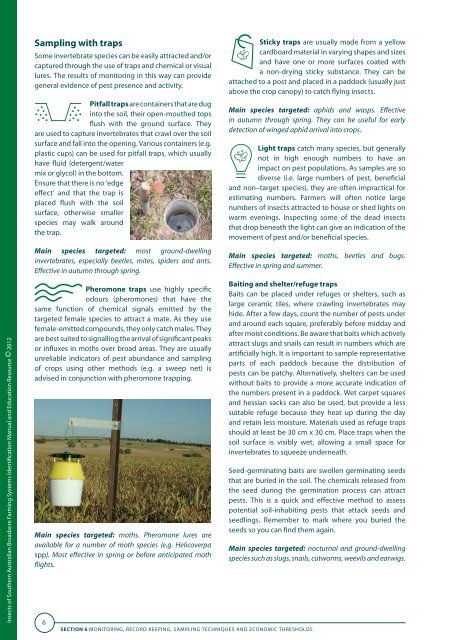Insects of Southern Australian Broadacre Farming Systems - Grains ...
Insects of Southern Australian Broadacre Farming Systems - Grains ...
Insects of Southern Australian Broadacre Farming Systems - Grains ...
You also want an ePaper? Increase the reach of your titles
YUMPU automatically turns print PDFs into web optimized ePapers that Google loves.
<strong>Insects</strong> <strong>of</strong> <strong>Southern</strong> <strong>Australian</strong> <strong>Broadacre</strong> <strong>Farming</strong> <strong>Systems</strong> Identification Manual and Education Resource © 2012<br />
Sampling with traps<br />
Some invertebrate species can be easily attracted and/or<br />
captured through the use <strong>of</strong> traps and chemical or visual<br />
lures. The results <strong>of</strong> monitoring in this way can provide<br />
general evidence <strong>of</strong> pest presence and activity.<br />
Pitfall traps are containers that are dug<br />
into the soil, their open-mouthed tops<br />
flush with the ground surface. They<br />
are used to capture invertebrates that crawl over the soil<br />
surface and fall into the opening. Various containers (e.g.<br />
plastic cups) can be used for pitfall traps, which usually<br />
have fluid (detergent/water<br />
mix or glycol) in the bottom.<br />
Ensure that there is no ‘edge<br />
effect’ and that the trap is<br />
placed flush with the soil<br />
surface, otherwise smaller<br />
species may walk around<br />
the trap.<br />
Main species targeted: most ground-dwelling<br />
invertebrates, especially beetles, mites, spiders and ants.<br />
Effective in autumn through spring.<br />
Pheromone traps use highly specific<br />
odours (pheromones) that have the<br />
same function <strong>of</strong> chemical signals emitted by the<br />
targeted female species to attract a mate. As they use<br />
female-emitted compounds, they only catch males. They<br />
are best suited to signalling the arrival <strong>of</strong> significant peaks<br />
or influxes in moths over broad areas. They are usually<br />
unreliable indicators <strong>of</strong> pest abundance and sampling<br />
<strong>of</strong> crops using other methods (e.g. a sweep net) is<br />
advised in conjunction with pheromone trapping.<br />
Main species targeted: moths. Pheromone lures are<br />
available for a number <strong>of</strong> moth species (e.g. Helicoverpa<br />
spp). Most effective in spring or before anticipated moth<br />
flights.<br />
6<br />
SECTION 6 MONITORING, RECORD KEEPING, SAMPLING TECHNIQUES AND ECONOMIC THRESHOLDS<br />
Sticky traps are usually made from a yellow<br />
cardboard material in varying shapes and sizes<br />
and have one or more surfaces coated with<br />
a non-drying sticky substance. They can be<br />
attached to a post and placed in a paddock (usually just<br />
above the crop canopy) to catch flying insects.<br />
Main species targeted: aphids and wasps. Effective<br />
in autumn through spring. They can be useful for early<br />
detection <strong>of</strong> winged aphid arrival into crops.<br />
Light traps catch many species, but generally<br />
not in high enough numbers to have an<br />
impact on pest populations. As samples are so<br />
diverse (i.e. large numbers <strong>of</strong> pest, beneficial<br />
and non–target species), they are <strong>of</strong>ten impractical for<br />
estimating numbers. Farmers will <strong>of</strong>ten notice large<br />
numbers <strong>of</strong> insects attracted to house or shed lights on<br />
warm evenings. Inspecting some <strong>of</strong> the dead insects<br />
that drop beneath the light can give an indication <strong>of</strong> the<br />
movement <strong>of</strong> pest and/or beneficial species.<br />
Main species targeted: moths, beetles and bugs.<br />
Effective in spring and summer.<br />
Baiting and shelter/refuge traps<br />
Baits can be placed under refuges or shelters, such as<br />
large ceramic tiles, where crawling invertebrates may<br />
hide. After a few days, count the number <strong>of</strong> pests under<br />
and around each square, preferably before midday and<br />
after moist conditions. Be aware that baits which actively<br />
attract slugs and snails can result in numbers which are<br />
artificially high. It is important to sample representative<br />
parts <strong>of</strong> each paddock because the distribution <strong>of</strong><br />
pests can be patchy. Alternatively, shelters can be used<br />
without baits to provide a more accurate indication <strong>of</strong><br />
the numbers present in a paddock. Wet carpet squares<br />
and hessian sacks can also be used, but provide a less<br />
suitable refuge because they heat up during the day<br />
and retain less moisture. Materials used as refuge traps<br />
should at least be 30 cm x 30 cm. Place traps when the<br />
soil surface is visibly wet, allowing a small space for<br />
invertebrates to squeeze underneath.<br />
Seed-germinating baits are swollen germinating seeds<br />
that are buried in the soil. The chemicals released from<br />
the seed during the germination process can attract<br />
pests. This is a quick and effective method to assess<br />
potential soil-inhabiting pests that attack seeds and<br />
seedlings. Remember to mark where you buried the<br />
seeds so you can find them again.<br />
Main species targeted: nocturnal and ground-dwelling<br />
species such as slugs, snails, cutworms, weevils and earwigs.

















